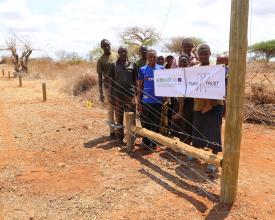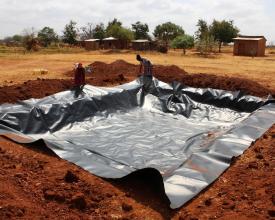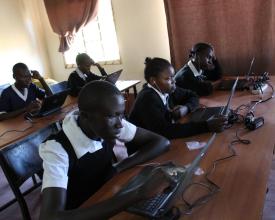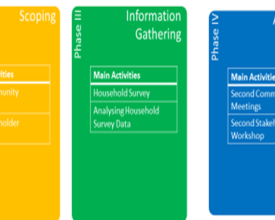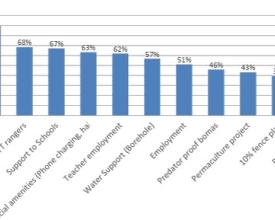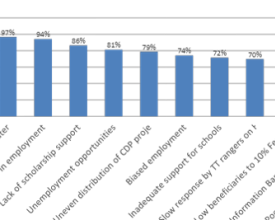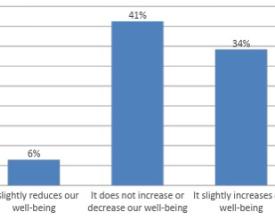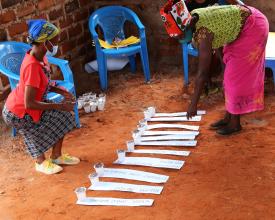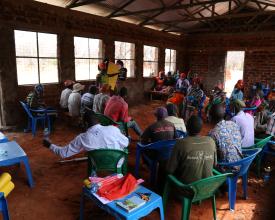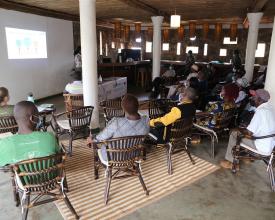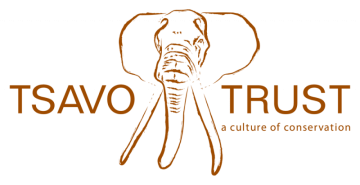
Enhancing Community Resilience against the impacts of COVID-19 in the Kamungi Conservancy, Southern Kenya

Tsavo Trust (TT) works in the Tsavo Conservation Area (TCA) which spans 42,000km2. It incorporates Tsavo East, Tsavo West and Chyulu Hills National Parks. Local communities surrounding the TCA have limited economic opportunities, unfavourable agricultural conditions, and lack basic governmental services, forcing some individuals to turn to illegal activities to survive.
TT applied the SAPA tool to the Kamungi Conservancy, a simple and low-cost methodology for assessing impacts of Protected Area (PA), conservation and development activities on the well-being of communities living within the PA. TT established a baseline of key social impacts, understood underlying causes for community challenges and identified ideas that positively contribute to communities' well-being.
TT constructed 4 10% fences (HWC mitigation) benefiting 40 people. M&E indicated a 100% decline in crop loss to wildlife, improved perceptions and improved livelihoods; reducing the pressure on the PA.
Context
Challenges addressed
TT used the SAPA tool to identify and prioritise Positive and Negative impacts from a beneficiaries perspective in Kamungi. The challenges identified by the study were hindering the process of community development and empowerment.
Challenges include; Human-Wildlife Conflict (HWC), the 1st ranked negative impact at 99%, TT has developed HWC mitigation measures i.e.10% Fence Plan and Elephant Exclusion Fence.
Access to water was the 2nd ranked negative impact at 97%; this is due to erratic rainfall patterns in the area, to address this, TT had sunk a borehole for the community and established 110 water pans.
Nepotism, lack of and bias in employment were ranked 3rd, 5th and 7th with 94%, 81%, and 74%. TT has employed over 45 permanent employees from communities to date.
In education, lack of scholarship support and inadequate support to schools were ranked 4th and 8th at 86% and 72%. TT has managed to raise funds for 9 scholarships and build a Science and Computer lab in a local secondary school.
Location
Process
Summary of the process
The SAPA process consists of 5 phases (preparation, Scoping, Information gathering, Assessing and Taking Action) some phases were combined in the building blocks and actual implementation to achieve the overall goal of SAPA assessment
Building Block 1, combined SAPA Phase 1 and 2, (Community Assessments) which included Planning the assessment, community mapping, reviewing existing information and identification and analysing stakeholders, conducting community FGDs to gather positive and negative impacts and the 1st Stakeholder meeting to add more positive and negative impacts
The process proceeded to Phases 3 and 4, "Data for decision making" in building block 2, a questionnaire from the prioritised impacts identified from the FGDs was developed, enumerators were trained on household data collection, the data collected was analysed and results shared with communities and 2nd stakeholders, who contributed to more positive and negative impacts
This led to the third and final block "Partnership Collaboration, Action Planning and monitoring progress" which comprised of sharing the results from the assessment with key stakeholders, answering assessment questions from the second stakeholder workshop and discussing ideas for action planning into thematic areas
Building Blocks
Preparing for Assessment
The objectives of the Preparing for Assessment block were:
- Conduct a feasibility check, to determine whether SAPA was an appropriate methodology for assessing the social impacts of Kamungi.
- Plan for the assessment, to ensure that the assessment was implemented as a high-quality multi-stakeholder process
- Conduct community mapping, to help ensure that SAPA included all relevant communities within Kamungi.
- Review existing information, To ensure the assessment builds upon existing data relevant to the design and implementation of the assessment.
- Conduct stakeholder analysis, To identify critical actors that should be engaged in SAPA
The SAPA team provided an overview of the SAPA to TT and Kamungi Conservancy management, this was followed by a community visit for mapping and awareness of the SAPA process, Two facilitators from Kamungi were identified, a male and a female, and trained for 2 days on gathering data from community members on positive and negative effects TT has had in the area. TT management provided the necessary data to facilitate the assessment and identified and ranked its stakeholders, clarifying their interests and Influence, the preparation phase helped set the base for the assessment ensuring all checkboxes were catered for and paving the way for the next building block
Enabling factors
TT management provided relevant information on their community interventions and facilitated in community mapping, they also provided a vehicle to support on logistics during the period.
TT contracted experienced consultants who conducted the SAPA process professionally within the set timelines
The good relationship between TT, Communities and Key Stakeholders made the participatory data collection process a success
Timely availing of project funds from BIOPAMA for the acities
Lesson learned
1. Through the SAPA process the TT identified the need to conduct more frequent meetings and community engagement in Kamungi Conservancy and surrounding villages that do not form part of the Kamungi Conservancy – especially on the projects TT is implementing.
2. We learned that it is important to update Communities and stakeholders on project interventions. This ensures that there is an element of project ownership and that its impacts are felt and measurable.
Data for Decision Making
The process involved in Data for decision-making included gathering information by conducting participatory community Focus Group Discussions (FGDs) and from key stakeholders, development of digital questionnaires, enumerators training on data collection, community data collection exercise and analysing the collected data to draw meaningful insights.
The data-gathering process involved participatory FGDs and engaging stakeholders, collecting information on the positive and negative impacts of Tsavo Trust (TT). This supported the development of a structured survey. The first Stakeholder meeting presented FGD findings, with participants providing additional insights. A digital questionnaire was created based on this input. Ten trained enumerators collected data from 156 households (approx. 950 individuals), achieving gender balance.
Community meetings shared survey results and ideas for addressing negative impacts. A second Stakeholder workshop gathered additional ideas. These components generated meaningful insights for decision-making.
These key components, including participatory discussions, stakeholder engagement, the development of a digital questionnaire, and data collection from households, were instrumental in generating meaningful insights for decision-making.
Enabling factors
Using community youths to collect the data ensured that we got a good reception from respondents who answered the questions truthfully without fear of victimisation.
The sharing of results with communities and allowing them to give ideas on mitigation of the prioritised negative impacts made the phase start getting direction on negative impacts mitigation.
Stakeholders identified in the 2nd Stakeholders meeting contributed towards by giving more ideas for action on the negative impacts.
Lesson learned
The community members shared local and traditional methods of mitigating the prioritised negative impacts which we found easy to implement with a small budget, this made us understand that sometimes the solution to otherwise big problems is with the people themselves and the need to be involving them in decision making.
TT learnt that bringing a wider network of stakeholders had varying benefits. Ensuring there was representation from County Government, like-minded NGO’s, Kenya Wildlife Services and Community helped TT and the stakeholders identify solutions/ideas for action for every negative impact identified. This helped reduce the pressures on TT to deliver and address all the negative impacts identified during the evaluation.
Sharing the information with the stakeholders also acted as a platform for Tsavo Trust to share what it does with The County Government, KWS and relevant stakeholders
Partnership Collaboration, Action Planning and monitoring progress:
A stakeholders workshop was conducted to share assessment results, address questions from the 2nd workshop, and discuss an action plan for mitigating identified negative impacts. Actions, activities, and timelines were discussed for each impact.
Based on the collected data, TT successfully engaged donors in funding projects aligned with reducing the negative impacts.
To mitigate the Human-Wildlife Conflict (HWC) negative impact, TT has constructed a 33km Elephant exclusion Fence and 8 additional 10% fences, reducing HWC by over 80%.
To address the lack of water, TT provided 110 dam liners, each with a capacity of 56,000 L, resulting in the harvesting of over 6 million litres of surface run-off water.
In support of schools, TT is offering scholarships to 9 students and has constructed and equipped a Science and computer laboratory in a local secondary school.
To overcome information barriers, TT established a BULK SMS platform and grievances log to facilitate communication on key issues, ongoing projects, and address grievances between TT and communities.
TT is currently developing a SAPA review scheduled for July 2023 to assess the impact and change in perceptions resulting from the implemented interventions in communities.
Enabling factors
The Tsavo Trust management was very supportive throughout the entire process.
Tsavo Trust contracted experienced consultants who conducted the SAPA process professionally within the set timelines
The good relationship between Tsavo Trust, Communities and Key Stakeholders made the process a success
Timely availing of project funds from BIOPAMA
Lesson learned
During the SAPA process final phase, TT learnt that bringing a wider network of stakeholders had varying benefits. Ensuring there was representation from County Government, like-minded NGOs, Kenya Wildlife Services and Community helped reduce the pressures on TT to deliver and address all the negative impacts identified during the evaluation. All partners who were part of the SAPA process now have a clear picture of the work that TT does and the needs of the Kamungi members.
Impacts
By conducting SAPA, TT identified gaps in perceptions by communities in regard to projects implemented in Kamungi, this was key in identifying community-led interventions to help improve their livelihoods and conservation of the PA.
The collected data is an essential baseline tool for resource mobilisation. As a result, TT has been able to secure funding from partners such as BIOPAMA, and 7 others to implement the joint action plan that was developed. 8 more 10% fences. TT scouts have undergone training and support in monthly elephant drives, driving 89 elephants from small scale farmland within Kamungi between January & March 2023. As a result of partner's support, TT provided 110 dam liners for water pans each with a capacity of 56,000L, reducing the distance covered by the communities to fetch water, TT is also providing scholarships for 9 students and has constructed and equipped a Science and computer laboratory in a local secondary school.
To address the information barrier between TT, communities and scouts, TT established a BULK SMS platform and grievances log which is used to communicate on Key issues, planned and ongoing projects and address grievances.
All 4 families with fences have reported 100% decline in HWC, improved livelihood, and improved perception towards wildlife.
Beneficiaries
Local communities living around Kamungi Conservancy
Local and National Government agencies
Kenya Wildlife Services (KWS)
Zoological Society of London (ZSL)
Sustainable Development Goals
Story
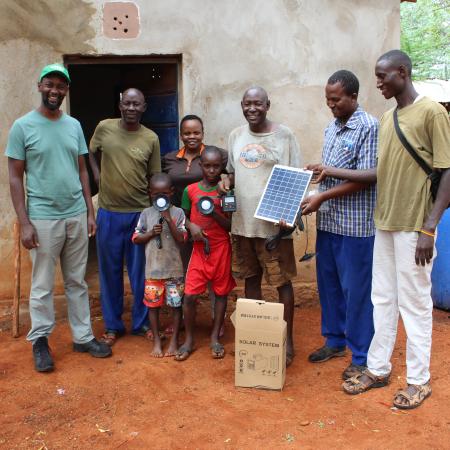
Through SAPA, TT identified the negative social impacts in Kamungi Conservancy. A joint action plan was developed to address the negative social impacts and improve the situation.
The following are some of the negative social impacts that were identified and interventions that TT has put in place to address them:
1. Human-Wildlife Conflict
- Installation of a 3-strand Elephant exclusion fence. Has significantly reduced Human – Elephant Conflict to over 7000 people by 80%.
- 10% Fence Plan (10% of a household’s land put under a porcupine electric fence). 8 more fences have been constructed with 80 people benefiting. M&E indicated a 100% decline in crop loss to wildlife, improved perceptions and livelihoods; reducing the pressure on the Protected Area (PA).
2. Long distance to fetch water
- Construction of 110 water pans. The water pans enable approximately 1,100 people to collect up to 6,160,000 Litres surface runoff water. kitchen gardens and tree nurseries have been established thus promoting food security and environmental conservation.
3. Lack of scholarship support
- Secondary Education full Scholarship to 9 needy students (6 girls and 3 boys) in boarding schools.
4. Inadequate support for schools
- Infrastructure Support: Completion and Equipping of Kyusyani Secondary School Science Laboratory.
- Equipping of a computer Laboratory at Kyusyani Secondary School – solar power, 20 Laptops, a Projector, and e-learning resources. This is expected to result in improved performance and improved enrolment of the school from the current 160 students.
5. Information barrier between TT and local communities
Bulk SMS was introduced and thus enabling communities to receive timely information from TT. The number of local community members participating in Tsavo Trust project activities has doubled.
6. Poor relationship with TT Rangers
Rangers attend community meetings on a quarterly basis where they respond to community queries and explain what their role entails.
7. 60 Local community members have been trained in climate-smart agriculture. This has improved their knowledge of dryland farming and best agricultural practices, thus enhancing food security.
8. 60 households received home solar solutions. This helps in reducing fossil fuel emissions and saves families approximately KES 1,620,000 per year.
The above interventions coupled with other existing interventions are already bearing fruits. The membership of Kamungi Conservancy increased by 80% in 2023.

